WORLD CLASS COACHING
Developing Soccer Intelligence Through 4v4 Vol 2
By Philip Cauchi
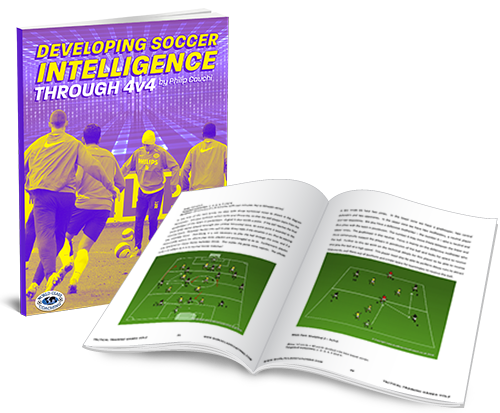
Table of Contents
PART TWO
Progressive Sessions
Progressive Sessions
Session number: 4.
Moment of the game: In possession.
Team task: Scoring.
Aim: Finish at goal with a shot.
Technical-tactical outcomes:
1. Staggered angles.
2. Insertions into attack.
3. Attitude to finish.
4. Follow up shots.
Duration of session: 87 to 90 minutes.
Number of players: 10 to 12 players.
Equipment:
Balls (at least four).
Bibs (one set of four bibs and another two of a different colour).
Markers (to mark zones and positions).
Mannequins (two and which can be replaced by cones).
Session plan:
Movement preparation and coordination: 20 minutes.
Shooting practice 1 – Dribble and shoot competition: 8 minutes.
Shooting practice 2 – Receive, turn and shoot competition: 8 minutes.
Shooting game – 2v2+1 with a perimeter player on each side: 15 minutes.
Shooting practice 3 – three player combination to shoot at goal: 10 minutes:
Game – 4v4+GKs: 26 minutes.
Movement preparation and coordination.
1. Running coordination – 5 minutes.
2. Dynamic flexibility – 5 minutes.
3. Agility and short sprints – 10 minutes.
Shooting practice 1 – Dribble and shoot competition.
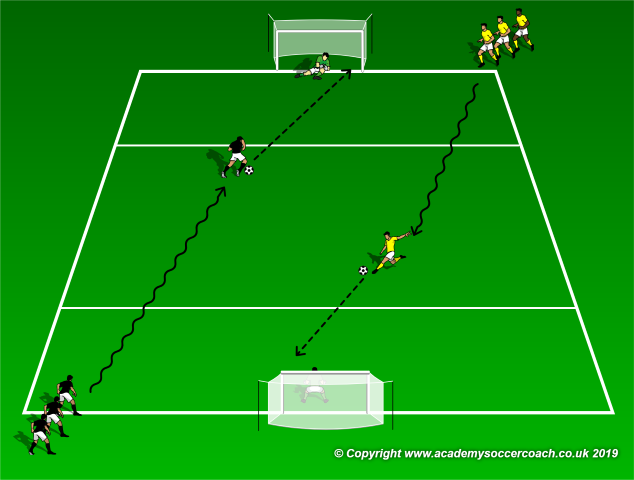
Remind players to focus on: aiming the shot for the least protected bottom corner of the goal.
Area: 40 yards in length by 30 yards in width.
Players: Each team has four players in a line and a goalkeeper in goal.
Duration: 8 minutes.
Description: First player of each team dribbles forward to shoot at goal before reaching the threshold line. After shooting, the ball is collected and the next player in line takes his turn to finish on goal. Play three minutes for two series to see which team has scored the most goals. Rest for two minutes between series.
Shooting practice 2 – Receive, turn and shoot competition.
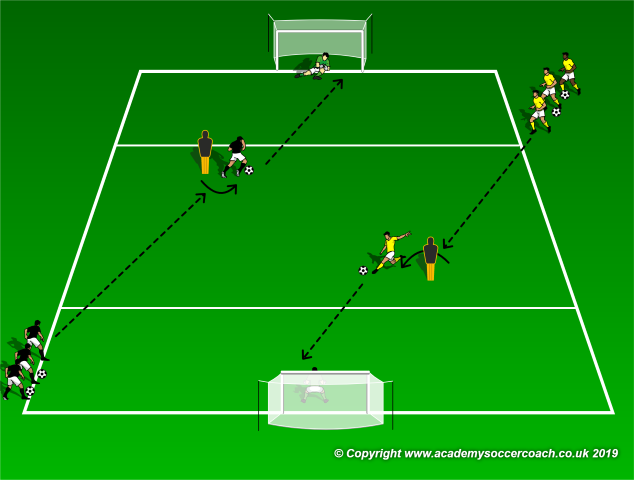
Remind players to focus on: aiming the shot for the least protected bottom corner of the goal.
Area: 40 yards in length by 30 yards in width.
Players: Each team has four players in a line and a goalkeeper in goal.
Duration: 8 minutes.
Description: The attacker with the ball passes to the attacker positioned in front of the mannequin. The latter turns around the mannequin to finish on goal. The passer becomes the finisher and moves in front of the mannequin for the same action to be repeated. Perform as a competition between the two teams and play for a total of three minutes to see which team emerges as the winner. Rest for two minutes and repeat the activity again for three minutes.
Shooting game – 2v2+1 with a perimeter player on each side.
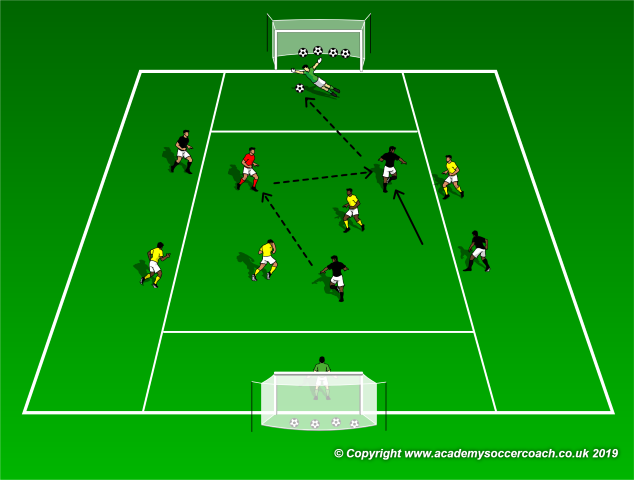
Remind players to focus on: 1) creating staggered angles and 2) have a positive attitude towards finishing on goal.
Area: 40 yards in length by 30 yards in width.
Players: Two players for each team inside the middle area with another perimeter player for each team on each flank zone. A neutral player plays with the team in possession inside the middle area.
Duration: 15 minutes.
Workload: 4 x 3 minutes with one minute rest in between series.
Description: One team attacks one goal and defends the opposite. Only the players inside the middle area are allowed to score. The perimeter players help the team keep possession of the ball. These player may not be tackled by any of the opposition’s team players, even by the opposite team’s flank player.
Shooting practice 3 – three player combination to shoot at goal.
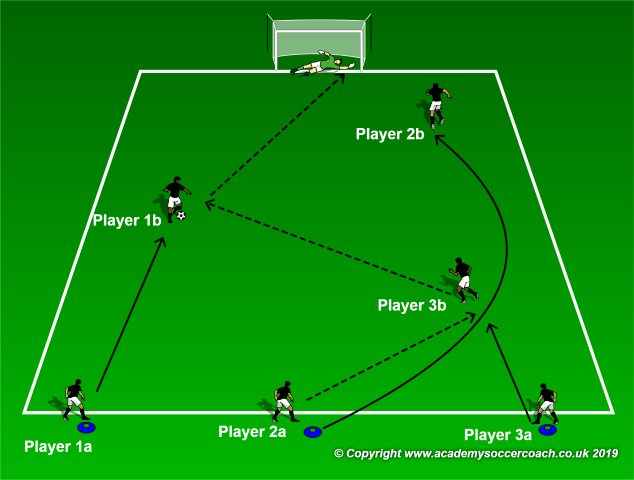
Remind players to focus on: 1) angles and timing of insertion runs, and 2) following up shots on goal.
Area: 40 yards in length by 30 yards in width.
Players: Attackers are divided into groups of three with a goalkeeper in goal. The attackers are positioned in positions 1, 2 and 3 as shown in the diagram above.
Duration: 10 minutes.
Description: Player 2 starts with the ball who passes to player 3. Player 2 overlaps player 3, while the latter passes to player 1 who has moved to an advanced position to receive and finish on goal. Player 2 follows the shot on the far post to finish off any rebounds.
Game – 4v4+GKs.
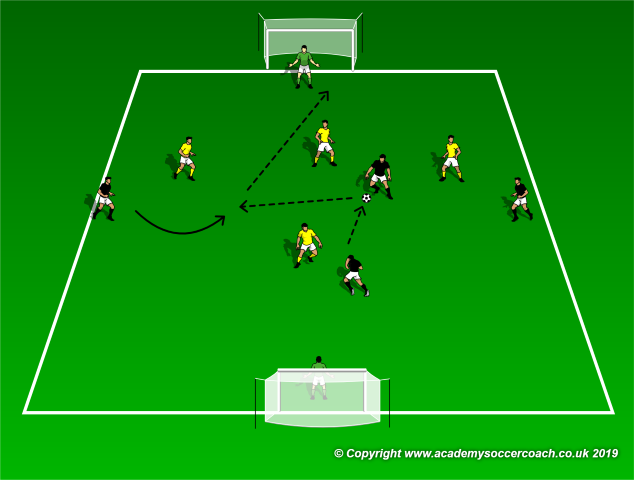
Remind players to focus on: 1) creating staggered angles, 2) having a positive attitude towards finishing on goal and 3) following shots for any rebounds.
Area: 40 yards in length by 30 yards in width with a regular goal positioned at each end line.
Players: Two teams of four outfield players and a goalkeeper.
Duration: 26 minutes.
Workload: 4 x 5 minutes with two minutes rest in between series.
Description: One team attacks one goal and defends the opposite. Normal game, however, there are no restarts. The goalkeeper of the team in possession starts the game whenever the ball goes out of playing bounds or a goal is scored.
Variation: If an extra player is present we can have one team that plays 5v4 in a numerical advantage. We might also play with a neutral player 4v4+1, or play 4v4 and rotate the resting player every two minutes.
Session number: 5.
Moment of the game: In possession.
Team task: Build-up.
Aim: Play line breaking passes to create scoring opportunities.
Technical-tactical outcomes:
1. Staggered angles.
2. Quality of passes.
3. Open body stance to receive the ball.
4. Direction oriented first touch.
Duration of session: 82 to 85 minutes.
Number of players: 10 to 12 players.
Equipment:
Balls (at least four).
Bibs (one set of four bibs).
Markers (two sets of a different colour).
Mini goals (four).
Session plan:
Movement preparation and coordination: 20 minutes.
Keep the rhythm – Dribble and move in a diamond formation: 5 minutes.
Keep the rhythm – Pass and move in a diamond formation (1): 5 minutes.
Keep the rhythm – Pass and move in a diamond formation (2): 5 minutes.
Passing practice – 4v1 rondo in a diamond formation: 5 minutes.
Passing practice – 4v2 to score on a mini goal: 10 minutes.
Game 1 – 4v2+2 score on both sides: 12 minutes.
Game 2 – 4v3+1: 20 minutes.
Movement preparation and coordination.
1. Running coordination – 5 minutes.
2. Dynamic flexibility – 5 minutes.
3. Agility and short sprints – 10 minutes.
Keep the rhythm – Dribble and move in a diamond formation.
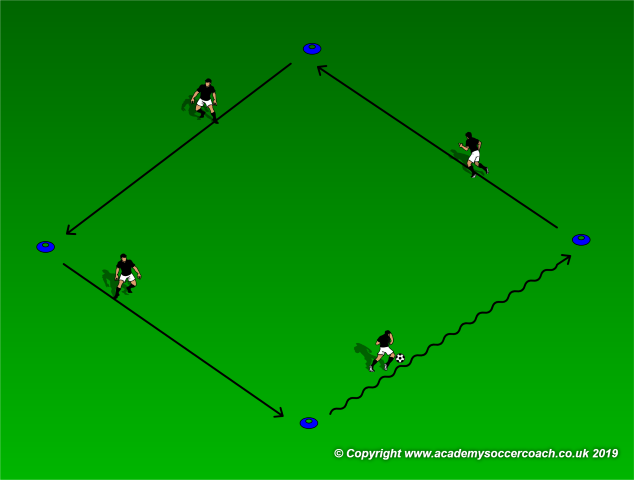
Remind players to focus on: arriving at the targeted marker at the same time as the dribbler.
Area: Diamond with each side measuring 10 yards in length.
Players: Four players, one of them with a ball.
Duration: 5 minutes.
Description: Player with the ball dribbles to either the marker to his right or left. The other players move to the corresponding marker, to either their right or left, and attempt to arrive at the same time as the dribbler. Once at the targeted marker, the player with the ball passes to any other player who repeats the sequence.
Keep the rhythm – Pass and move in a diamond formation (1).
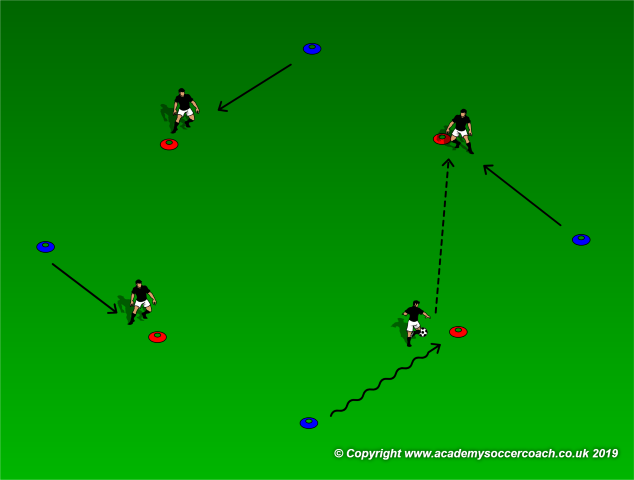
Remind players to focus on: keeping the structure of the diamond intact.
Area: Diamond with each side measuring 10 yards in length.
Players: Four players, one of them with a ball.
Duration: 5 minutes.
Description: Player with the ball dribbles to either the marker to his right or to his left. The dribbler may choose to pass the ball when he gets to the red marker, continue dribbling or return back from the start. The other players must respond accordingly.
Progression: The player with the ball may dribble diagonally towards the opposite player. In this case, the other players must quickly move to find a new space (blue marker) so to establish the shape of the diamond again.
Keep the rhythm – Pass and move in a diamond formation (2).
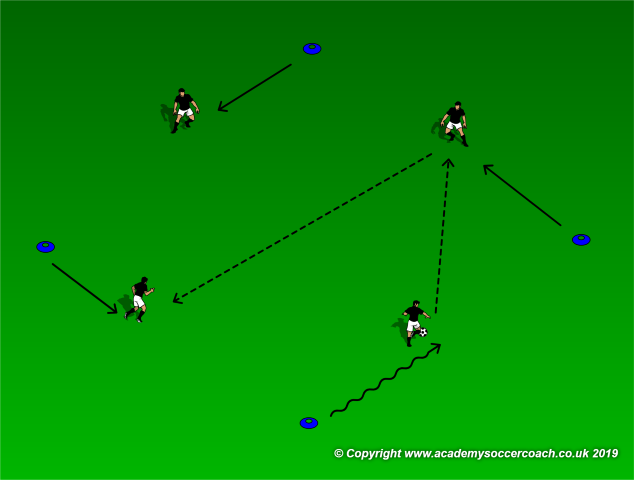
Remind players to focus on: keeping the structure of the diamond intact.
Area: Diamond with each side measuring 10 yards in length.
Players: Four players, one of them with a ball.
Duration: 5 minutes.
Description: Player with the ball dribbles to either the marker to his right or left. The dribbler may choose to dribble or pass the ball. In any case the shape of the diamond must remain intact.
Progression: The player with the ball may dribble at different speeds when between markers. In the diagram above it could be that the player instead of passing the ball, dribbled towards the opposite player. In this case all the other three players must move accordingly to re-establish the shape of the diamond.
Passing practice – 4v1 rondo in a diamond formation.
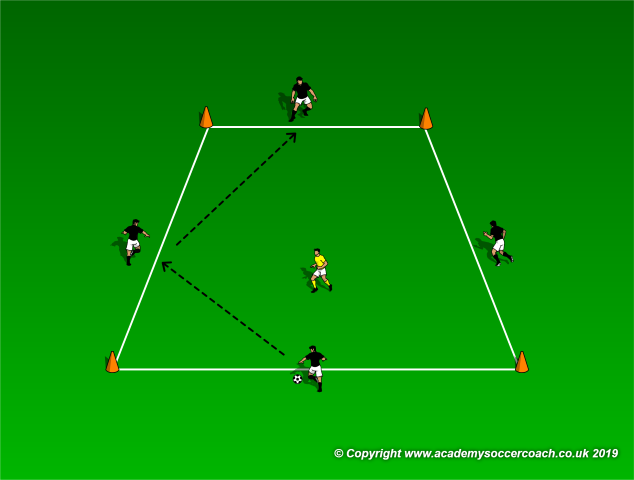
Remind players to focus on: 1) receiving the ball using an open body stance and 2) keeping the shape of the diamond.
Area: 10 yards in length by 8 yards in width.
Players: Four attackers and one defender.
Duration: 5 minutes.
Description: Players must move along their designated side of the area. If the defender wins the ball, he attempts to dribble it outside the area by playing a 1v1 against the attacker who lost it.
Progression: Play with a two touch restriction so to work on using the correct body stance and applying the right touch on the ball.
Passing practice – 4v2 to score on a mini goal.
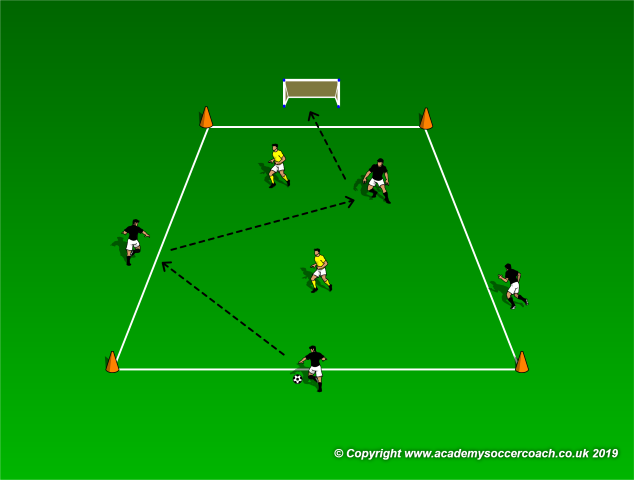
Remind players to focus on: 1) receiving the ball using an open body stance and 2) keeping the shape of the diamond.
Area: 12 yards in length by 10 yards in width.
Players: Four attackers and two defenders.
Duration: 10 minutes.
Workload: 7 x 1 minute with thirty seconds rest in between series.
Description: Attackers always start building their attack from the end line opposite the mini goal as shown in the above diagram. The attackers aim to score in the mini goal which is positioned two yards behind the perimeter of the area, thus preventing the defenders from goal tending. If the defenders win the ball they counter by dribbling the ball on the opposite line where they play 2v2 with the inside attacker and the attacker on the end of the end line. Rotate the defenders every minute.
Progression: Attackers must score in a pre-allotted time. Therefore they are forced to apply the correct technique during the circulation of the ball and build-up of the attack.
Game 1 – 4v2+2 score on both sides.
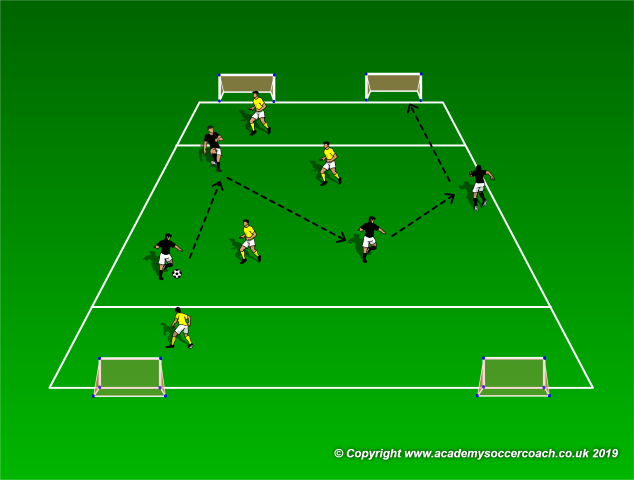
Remind players to focus on: creating passing angles and playing forward whenever possible.
Area: 15 yards in length by 12 yards in width.
Players: Four attackers and two defenders plus a defender in each end zone.
Duration: 12 minutes.
Workload: 8 x 1 minute with thirty seconds rest in between series.
Description: The four attackers aim to score in either of the four mini goals. In order to do so they have to overcome the resistance of the two defenders and the defenders inside the end zones. Attackers may only score from outside the end zones while the defenders inside the end zones may intercept these passes/shots. Once a goal is scored, the attackers restart from the middle of the area. Play four series and then team switch roles in this game. Perform the exercise as a competition between teams.
Game 2 – 4v3+1.
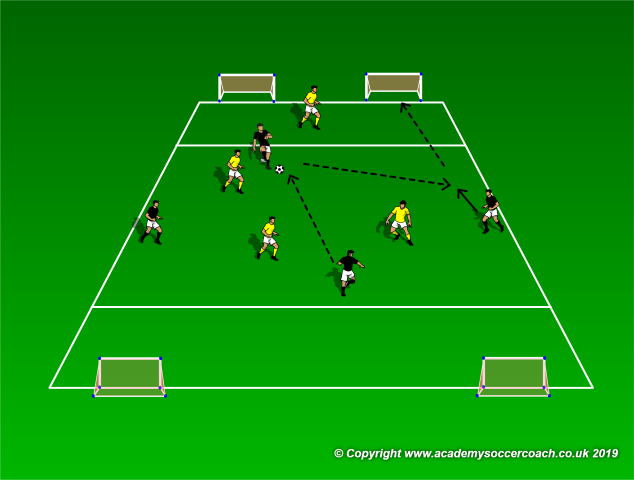
Remind players to focus on: creating passing angles and playing forward whenever possible.
Area: 20 yards in length by 15 yards in width.
Players: Four attackers and three defenders plus another defender in the end zone.
Duration: 20 minutes.
Workload: 4 x 4 minutes with one minute rest in between series.
Description: The attacking team aims to score in either of the two mini goals positioned on the end line. They play 4v3 against the defending team while another defender is positioned in the end zone with the aim of intercepting passes/shots on the mini goals. Whenever the ball goes out of bounds play starts by the team in possession from their end zone. In case the attacking team scores or the ball goes out of play, the teams change roles and the defending team now becomes the attacking team and attacks with four players. The previously attacking team now defends with three players in the middle zone and another player inside their end zone.
Session number: 6.
Moment of the game: Opponents in possession.
Team task: Deny the build-up.
Aim: Prevent the opponents from playing line-breaking passes.
Technical-tactical outcomes:
1. Remain compact.
2. Cut off forward passing lanes.
3. Force the ball away from goal.
4. Move together as a group.
Duration of session: 80 minutes.
Number of players: 12 players.
Equipment:
Balls (at least four).
Bibs (one set of four bibs).
Markers (two sets of a different colour).
Mini goals (four).
Session plan:
Movement preparation and coordination: 15 minutes.
Principles of defending – prevent the forward pass: 15 minutes.
Game 1 – defend your goal 4v4+4: 15 minutes.
Game 2 – defend your goal 4v4+4: 15 minutes.
Game 3 – 4v4+GKs: 20 minutes.
Movement preparation and coordination.
1. Ball mastery – 10 minutes.
2. Dynamic flexibility and mobility – 5 minutes.
Principles of defending – prevent the forward pass.
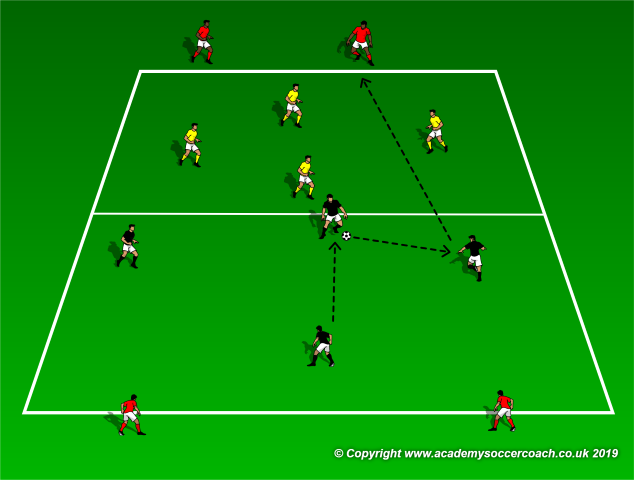
Remind players to focus on: cutting of the passing lanes to the attackers positioned in the opposite side.
Area: 40 yards in length by 30 yards in width divided into two equal horizontal zones.
Players: Three groups of four players each. Two groups are positioned in their respective zone while the others (the neutrals) have two players at each end line acting as target players.
Duration: 15 minutes.
Description: Both teams aim to play the ball to the opposite target players to score a point. Rotate team roles every four minutes.
Variation: To speed up play and make it more challenging for the defending team, the attacking team aims to score within twenty seconds, otherwise they lose possession.
Game 1 – defend your goal 4v4+4.
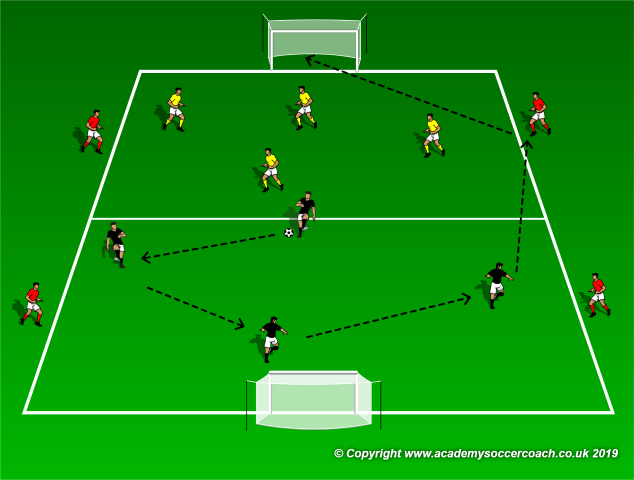
Remind players to focus on: 1) remaining compact and 2) moving together as a group on a switch in play.
Area: 40 yards in length by 30 yards in width divided into two equal horizontal zones. A regular goalpost is positioned at each end line.
Players: Three groups of four players each. Two groups are positioned in their respective zone while the other (the neutrals) are positioned at the sides as shown in the diagram above. No goalkeepers are included in this exercise.
Duration: 15 minutes.
Workload: 3 x 4 minutes with one minute rest in between series.
Description: Both teams try to find a way to score either by shooting directly from their zone or by passing to the neutral players on the flanks to finish themselves. The neutral players are allowed to pass to each other. There is one condition that both teams must adhere to. They must always play in a diamond formation, both when they have the ball and also when the opponents have the ball.
Game 2 – defend your goal 4v4+4.
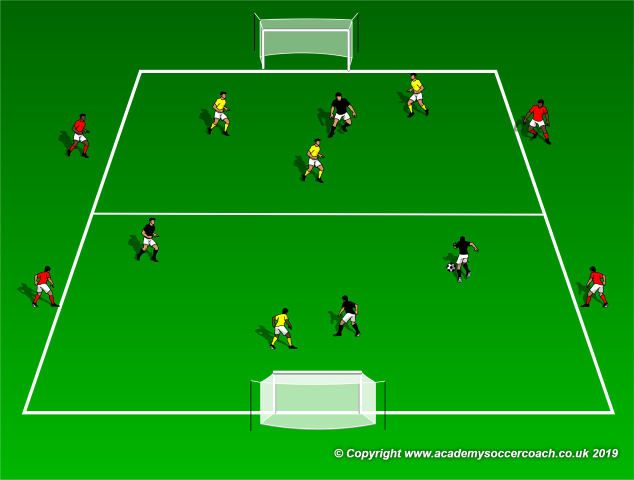
Remind players to focus on: 1) remaining compact and 2) moving together as a group on a switch of play.
Area: 40 yards in length by 30 yards in width divided into two equal horizontal zones. A regular goalpost is positioned at each end line.
Players: Three groups of four players each. Two groups have three defenders and an attacker, while another group is composed of four neutral players and which are positioned at the sides of the area as shown above.
Duration: 15 minutes.
Workload: 3 x 4 minutes with one minute rest in between series.
Description: Same as the previous exercise but now each team has an attacker in the opposition’s half of the pitch, while having one player less in defence. This increases the scoring options for the attacking team.
Progression: An attacker in possession of the ball in his own half may dribble into the attacking half to create a numerical advantage for the attacking team (taking the neutral players into consideration it becomes a 4v3 in favour of the attacking team).
Game 3 – 4v4+GKs.
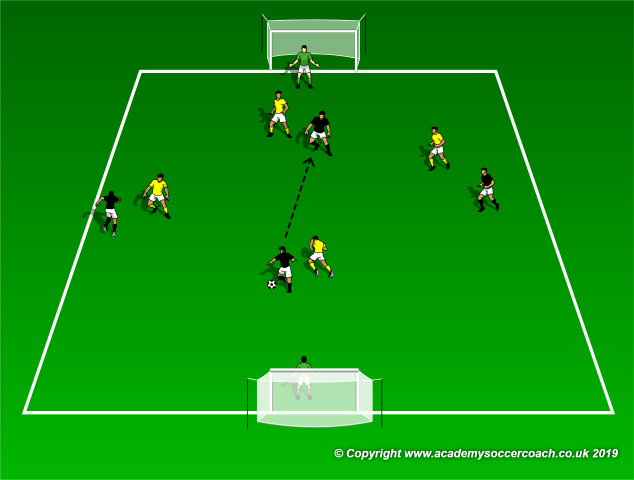
Remind players to focus on: 1) remaining compact and 2) forcing play away from goal.
Area: 40 yards in length x 30 yards in width. A regular goalpost is positioned at each end line.
Players: Two teams of four outfield players plus a goalkeeper each team.
Duration: 20 minutes.
Workload: 2 x 9 minutes with two minutes rest in between.
Description: Normal game but with restarts starting from the goalkeeper of the team in possession. This gives the defending team time to adjust itself during this moment of play, thus reinforcing the principles of defending by having all the team adjusted to the correct positions on the pitch.
Progression: Divide the pitch into two equal horizontal zones. Each team has a defensive half and an offensive half. If a team scores from inside the offensive half the goal counts double. This forces the players to be more compact and not to give too much space to the opponents near the goal.


